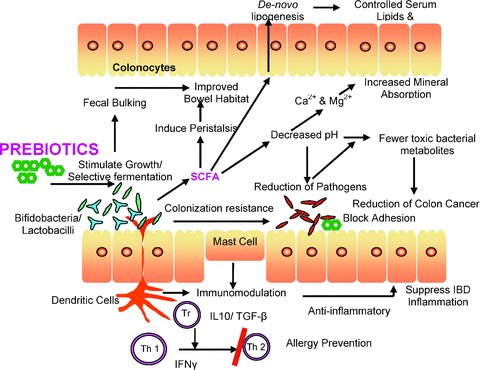A New Prebiotic Ingredient
May 7, 2012 Written by JP [Font too small?]There’s an old adage that says to avoid foods that contain ingredients you can’t easily pronounce. The purest interpretation might lead one to steer clear of processed foods altogether. I’m fully supportive of this philosophy provided that it works for you. However, in my experience, most people eat at least some pre-packaged or refined foods. And, much to the chagrin of purists, sometimes hard to pronounce ingredients are actually quite good for you.
In the near future you’ll probably see an ingredient by the name of xylooligosaccharides (XOS) in a number of “functional foods” available in both health food stores and markets. Currently, there are plans to add XOS to everything from baby food to yogurt. If you’re wondering whether this is a welcome development or not, consider the following. First of all, XOS is just the latest in a long line of prebiotic fibers much like fructooligosaccharides (FOS) and inulin. Despite what some might say, it really isn’t anything spectacularly new or novel. Secondly, almost everyone has already been exposed to XOS to some extent because it’s present in small amounts in a variety of foods including bamboo shoots, milk and rice bran. The only thing that’s changed lately is that biotechnology companies have discovered an economically viable way to extract and purify XOS from corncobs.
To date, several human studies involving XOS have been published in peer-reviewed medical journals. The bulk have focused on the utility of XOS in relation to digestive wellness and liver health. The latest, appearing in the January 2012 issue of the British Journal of Nutrition, examined the effects of XOS or XOS plus inulin in 60 healthy volunteers. The findings revealed that supplementing with XOS promoted the growth of beneficial bacteria and that XOS combined with inulin attenuated inflammation caused by an unhealthy diet. This conclusion is supported by previous research that found that: a) XOS preferentially stimulated the growth of two important probiotics (Bifidobacterium bifidum and Lactobacillus plantarum) which protect against pathogenic microorganisms such as E. coli and Salmonella; b) a daily dose of 4.2 grams/day of XOS dramatically and safely improved bowel function in a group of pregnant women with severe constipation.
My initial impression of XOS is generally optimistic. For starters, I’m reassured by the fact that it naturally occurs in traditionally consumed foods. Also of interest for me was an 8 week study published in October 2008. In it, a group of type 2 diabetics were given either a placebo or 4 grams of XOS daily. Those receiving XOS exhibited uniformly positive results. The authors of the trial noted a decline in blood sugar, fructosamine, LDL (“bad”) and oxidized cholesterol in the experimental group. Since XOS is technically a carbohydrate source, I think it’s vital to establish its safety in at risk populations such as diabetics. This preliminary study suggests that this prebiotic is suitable for those concerned about blood sugar control. If these results can be replicated in larger studies involving non-diabetics, then it’s quite possible that XOS could prove to be a valuable addition to many processed foods.
To learn more about the studies referenced in today’s column, please click on the following links:
Study 1 – Xylooligosaccharides (XOS) as an Emerging Prebiotic: Microbial … (link)
Study 2 – Xylo-oligosaccharide (XOS) in Combination with Inulin Modulates … (link)
Study 3 – In Vitro Investigations of the Effect of Probiotics and Prebiotics On … (link)
Study 4 – Effect of Xylooligosaccharide Intake on Severe Constipation in Pregnant … (link)
Study 5 – Effects of Xylooligosaccharides in Type 2 Diabetes Mellitus … (link)
Prebiotics Promote Wellness via Multiple Mechanisms
Source: Comp. Reviews in Food Science and Food Safety, January 2011 (link)
Tags: Constipation, Diabetes, Prebiotics
Posted in Diabetes, Food and Drink, Nutrition



May 7th, 2012 at 3:57 pm
JP, Like this article. While trying to advocate ‘eating as natural’ as possible (less processed foods, etc.) we can fail to realize that some food additives could be positive.
Appreciate your article, as always!
May 8th, 2012 at 11:50 am
Thank you, Mary!
Be well!
JP
February 10th, 2018 at 12:53 pm
Hi JP,
Very informative article, thank you.
I’ve been trying to research pre-biotics to supplement our diets. We’re currently taking pro-biotics, and only recently learned about “feeding” the flora to keep it healthy and reproductive.
My question is:
Are there natural sources that we can augment our diets with, without having to resort to a processed product?
From what i’ve been able to determine, both rice and bamboo shoots are natural sources for XOS, but most fruits and all grains are restricted from my Wife’s diet, and i can’t find any data on how to translate canned bamboo shoot (or other natural source, e.g. veggies, milk, honey, etc.) into a “recommended daily dose” of XOS.
There are surely sources out there that address these two issues, and i will truly appreciate it if you could direct me to discussions, research papers, or web sites that deal specifically with using unrefined food sources for XOS.
Sincere Thanks,
Steve
February 14th, 2018 at 1:39 am
Hi Stephen,
Yes! Prebiotics are present in many plant-based foods. I’m talking about common items such as asparagus, berries, jicama, onions, tree nuts and many, many others. Also, one can easily obtain adequate/optimal amounts of prebiotics without resorting to grains. That’s what I do.
https://www.healthyfellow.com/1946/prescription-2015-feed-your-good-gut-bacteria/
I appreciate your wanting to quantify the amount of XOS in food. Unfortunately, I don’t have a good resource to assist with that. For what it’s worth, I generally recommend taking a broader view of this issue. From a food standpoint, this means slowly increasing the number of nutrient-dense, prebiotic foods in your daily diet. See which ones are tolerated well and which are not. And, as you mentioned earlier, consider providing direct sources of beneficial bacteria alongside the prebiotic fiber – homemade yogurt (dairy-free is an option), kimchi, sauerkraut, etc.
I find that a tailored approach tends to work out best – especially for those on restricted diets.
I hope this is helpful.
Be well!
JP